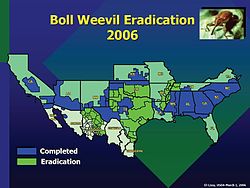Boll Weevil Eradication Program
The Boll Weevil Eradication Program is a program sponsored by the
History
Since its migration from Mexico in the late 19th century, the boll weevil had been the single most destructive cotton pest in the United States, and possibly the most destructive agricultural pest in the United States. The cost of its crop depredations has been estimated at $300 million per year.[2] The control measures used have included a wide range of pesticides, including calcium arsenate, DDT, toxaphene, aldrin, dieldrin, endrin, heptachlor, malathion, and parathion. In 1958, the National Cotton Council garnered the Congressional support to create the USDA Boll Weevil Research Lab.

In 1959 J. R. Brazzel and
The first full-scale eradication trial began in 1978 in southern Virginia and eastern North Carolina. After initial success, the USDA's APHIS (Animal and Plant Health Inspection Service) agency established an eradication plan. The cost of the program was borne both by APHIS (30%) and by the producer (70%). Since the weevil can travel long distances quickly, it was important to implement the program on a regional basis. Expansion of the program usually required cotton producers within the area of proposed expansion to pass a referendum with at least a two-thirds majority. Some states passed legislation to help growers pay their share of program costs.
The program was extended into the southeast and southwest during the 1980s. Eradication is now complete in all cotton growing states except Texas, where problems along the Mexican border have halted the program there. Eradication was not complete in Texas as of 2022.[4]
Operation
USDA’s Animal and Plant Health Inspection Service (APHIS) provides technical support and limited Federal funds. The state departments of agriculture provide regulatory support, and USDA’s Cooperative State Research, Education, and
Three main techniques are employed over a 3-5-year period:
In portions of its range, the program has been bolstered by the spread of the
Impacts
At one time, cotton growers applied more than 41 percent of all insecticides in agricultural use; they regularly sprayed their cotton as many as 15 times a season. In contrast, under this program, only two applications are made by the third year, and this number may be reduced to nearly zero when the nationwide program is completed. The
The
References
- ^ Current Status of Boll Weevil Eradication Program, National Cotton Council, Fall 2009
- ^ Boll weevil economic impacts
- ISSN 1938-291X.
- ^ "Welcome". Texas Boll Weevil Eradication Foundation, Inc. Retrieved 2013-10-07.
- ^ US EPA - Cotton pesticide considerations Archived 2004-09-28 at the Wayback Machine
- ^ Boll weevil eradication: a model for sea lamprey control? Journal of Great Lakes Research 2003
